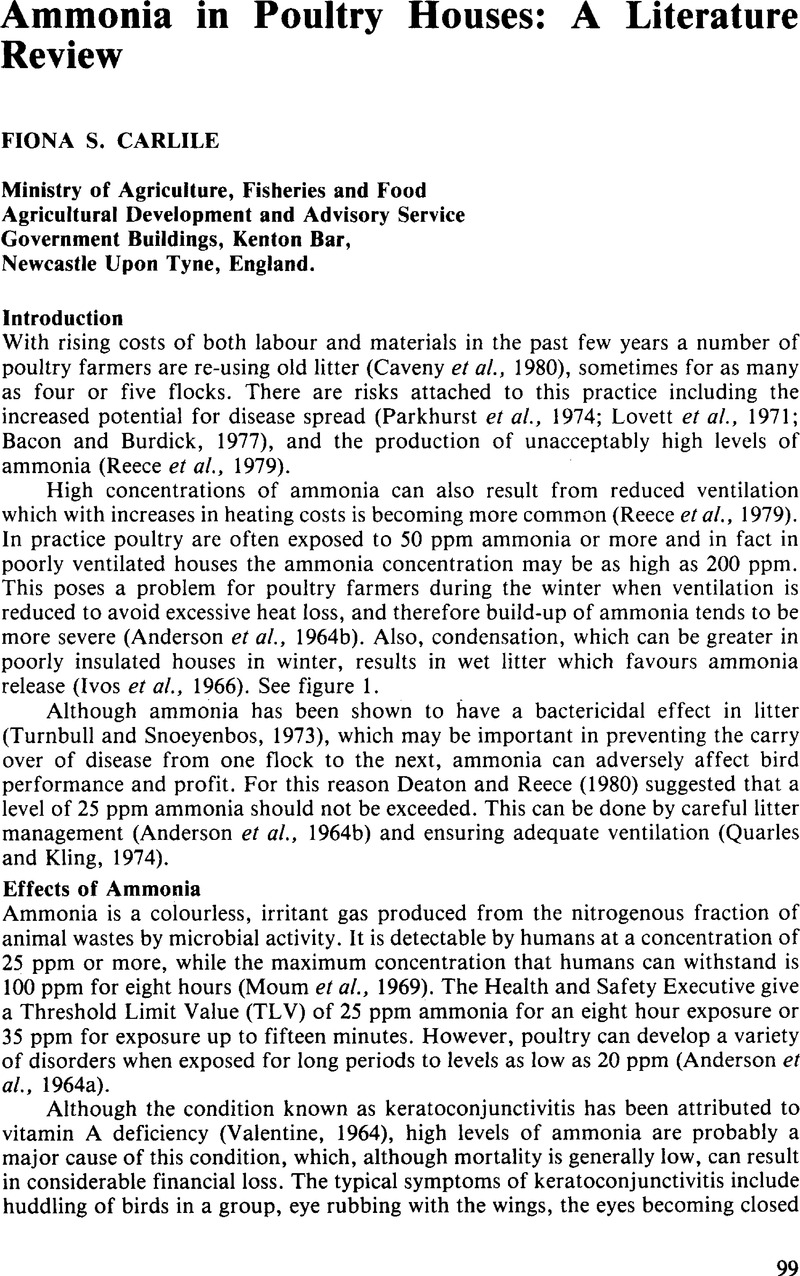Crossref Citations
This article has been cited by the following publications. This list is generated based on data provided by Crossref.
DOSORETZ, CARLOS
and
LAMED, RAPHAEL
1987.
Chicken Manure Methanogenesis..
Poultry Science,
Vol. 66,
Issue. 4,
p.
576.
PIMENTEL, J.L.
and
COOK, M.E.
1988.
Improved Growth in the Progeny of Hens Immunized with Jackbean Urease.
Poultry Science,
Vol. 67,
Issue. 3,
p.
434.
Kempf, Isabelle
Cacou, P.M.
Guittet, Michèle
Ollivier, Claudine
Morin, M.
L'hospitalier, Rolande
and
Bennejean, G.
1988.
Mycoplasmose amycoplasma gallisepticum: Realisation d'un modele experimental role de l'ammoniac comme facteur d'exacerbation.
Avian Pathology,
Vol. 17,
Issue. 3,
p.
601.
Hauser, R. H.
and
Fölsch, D. W.
1988.
Methods for Measuring Atmospheric Dust, Micro‐Organisms and Ammonia in Poultry Houses: Review and Approved Practices.
Journal of Veterinary Medicine, Series B,
Vol. 35,
Issue. 1-10,
p.
579.
Mahimairaja, S.
Bolan, N. S.
Hedley, M. J.
and
Macgregor, A. N.
1990.
Evaluation of methods of measurement of nitrogen in poultry and animal manures.
Fertilizer Research,
Vol. 24,
Issue. 3,
p.
141.
WEAVER, WILLIAM D.
and
MEIJERHOF, R.
1991.
The Effect of Different Levels of Relative Humidity and Air Movement on Litter Conditions, Ammonia Levels, Growth, and Carcass Quality for Broiler Chickens.
Poultry Science,
Vol. 70,
Issue. 4,
p.
746.
TERADA, A.
HARA, H.
SAKAMOTO, J.
SATO, N.
TAKAGI, S.
MITSUOKA, T.
MINO, R.
HARA, K.
FUJIMORI, I.
and
YAMADA, T.
1994.
Effects of Dietary Supplementation with Lactosucrose (4G-β-D-Galactosylsucrose) on Cecal Flora, Cecal Metabolites, and Performance in Broiler Chickens.
Poultry Science,
Vol. 73,
Issue. 11,
p.
1663.
Mahimairaja, S.
Bolan, N.S.
Hedley, M.J.
and
Macgregor, A.N.
1994.
Losses and transformation of nitrogen during composting of poultry manure with different amendments: An incubation experiment.
Bioresource Technology,
Vol. 47,
Issue. 3,
p.
265.
Skewes, P.A.
and
Harmon, J.D.
1995.
Ammonia Quick Test and Ammonia Dosimeter Tubes for Determining Ammonia Levels in Broiler Facilities.
Journal of Applied Poultry Research,
Vol. 4,
Issue. 2,
p.
148.
Shreve, B. R.
Moore, P. A.
Miller, D. M.
Daniel, T. C.
and
Edwards, D. R.
1996.
Long‐term phosphorus solubility in soils receiving poultry litter treated with aluminum, calcium, and iron amendments.
Communications in Soil Science and Plant Analysis,
Vol. 27,
Issue. 11-12,
p.
2493.
MOORE, P.A.
DANIEL, T.C.
EDWARDS, D.R.
and
MILLER, D.M.
1996.
Evaluation of Chemical Amendments to Reduce Ammonia Volatilization from Poultry Litter.
Poultry Science,
Vol. 75,
Issue. 3,
p.
315.
Moore Jr, P
1997.
Animal Waste Utilization.
p.
89.
Amon, Marko
Dobeic, Martin
Sneath, Robert W.
Phillips, V.Roger
Misselbrook, Tom H.
and
Pain, Brian F.
1997.
A farm-scale study on the use of clinoptilolite zeolite and De-Odorase® for reducing odour and ammonia emissions from broiler houses.
Bioresource Technology,
Vol. 61,
Issue. 3,
p.
229.
Ricke, S.C.
Nisbet, D.J.
and
Maciorowski, K.G.
1997.
Batch culture growth response of a poultry Salmonella typhimurium isolate to ammonium salts.
Bioresource Technology,
Vol. 60,
Issue. 2,
p.
107.
Terzich, M.
Quarles, C.
Goodwin, M. A.
and
Brown, J.
1998.
Effect of Poultry Litter Treatment® (PLT®) on the development of respiratory tract lesions in broilers.
Avian Pathology,
Vol. 27,
Issue. 6,
p.
566.
Ferguson, N.S.
Gates, R.S.
Taraba, J.L.
Cantor, A.H.
Pescatore, A.J.
Ford, M.J.
and
Burnham, D.J.
1998.
The effect of dietary crude protein on growth, ammonia concentration, and litter composition in broilers.
Poultry Science,
Vol. 77,
Issue. 10,
p.
1481.
Edens, F.W.
Joyce, K.A.
Parkhurst, C.R.
Havenstein, G.B.
and
Qureshi, M.A.
1998.
Effect of litter moisture and brooding temperature on body weights of turkey poults experiencing poult enteritis and mortality syndrome.
Poultry Science,
Vol. 77,
Issue. 3,
p.
411.
Moore, PA
Daniel, TC
and
Edwards, DR
1999.
Reducing phosphorus runoff and improving poultry production with alum.
Poultry Science,
Vol. 78,
Issue. 5,
p.
692.
Sampaio, M.A.P.M.
Schocken-Iturrino, R.P.
Sampaio, A.A.M.
Berchielli, S.C.P.
and
Biondi, A.
1999.
Estudo da população microbiana e da liberação de amônia da cama de frangos tratada com gesso agrícola.
Arquivo Brasileiro de Medicina Veterinária e Zootecnia,
Vol. 51,
Issue. 6,
p.
559.
Martrenchar, A.
1999.
Animal welfare and intensive production of turkey broilers.
World's Poultry Science Journal,
Vol. 55,
Issue. 2,
p.
143.



